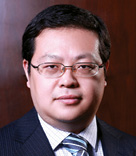The first paragraph of article 6 of the Patent Law specifies that “an invention-creation, made by a person in execution of the tasks of the entity to which he [or she] belongs, or made by him [or her] mainly by using the material and technical means of the entity is a service invention-creation. For a service invention-creation, the right to apply for a patent belongs to the entity. After the application is approved, the entity shall be the patentee”.
Article 16 of the Patent Law specifies that “the entity that is granted a patent right shall award to the inventor or creator of a service invention-creation a reward and, upon exploitation of the patented invention-creation, shall pay the inventor or creator a reasonable remuneration based on the extent of spreading and application and the economic benefits yielded”. In this way, an inventor can, to a certain extent, share with the patent holder in the economic benefits derived from the patent.

Liu Guangming
中原信达
合伙人、专利代理人
Partner, Patent Attorney
China Sinda
Implementing rules
The Implementing Rules of the Patent Law specifically provide for reward and remuneration for inventors in chapter 6. Article 76 of the rules establishes the principle of priority of agreement. An entity may enter into a contract with the inventor, or specify in its rules and regulations, the manner and the amount of reward and remuneration.
In the absence of an agreement or rules and regulations, articles 77 and 78 of the rules provide for the statutory rates for reward and remuneration respectively. In terms of reward, the bonus paid to an inventor should not be less than RMB3,000 (US$480) for an invention and not less than RMB1,000 for a utility model or design. In terms of remuneration, if the entity directly uses the patent, it should aside not less than 2% of the profit derived from the use of the patent each year, in the case of an invention or utility model, or not less than 0.2% in the case of a design, or refer to the foregoing percentages in giving remuneration in one lump sum; or if the entity licenses another to use its patent, it should set aside not less than 10% of the royalties as remuneration.
First, let us look at the scope of application of the Patent Law and rules. One viewpoint has it that their provisions on reward and remuneration for inventors only apply to China patents. Another viewpoint holds that so long as an invention or creation is completed in China, regardless of whether a China patent or foreign patent is applied for, the above-mentioned provisions apply.
Establish a reward system
The author leans toward the second viewpoint. The Guidelines for the Trial of Disputes Involving Reward and Remuneration of Inventors or Creators of Service Invention-Creation, formulated by the Intellectual Property Tribunal of the Shanghai Municipal Higher People’s Court in 2013, also support this viewpoint. Accordingly, the author would recommend that Chinese and foreign enterprises, particularly multinationals, establish an inventor reward and remuneration system in their China parents or subsidiaries.
Let us turn to the principle of priority of agreement. The author recommends that the patentee and inventor enter into an agreement in advance. The broad meaning of “agreement” includes the entity’s rules and regulations, in addition to the contract between the parties. In contrast to the statutory rates, an agreement offers a greater degree of freedom. For example, reward and remuneration, in addition to taking monetary form, can take such forms as stock, options, promotion, a raise, paid leave, etc. The agreed amount may be higher or lower than the statutory rates. Of course, one can simply adopt the statutory rates.
Unfair equals invalid
From the perspective of respecting the autonomy of will of the parties, if an agreement is reached based upon the statutory procedure, it can be assumed to be reasonable and valid; however, if the agreement is unfair, it will be invalid. The Draft Regulations for Service Inventions require the exclusion of any provisions that deny the rights enjoyed by an inventor or that attach unreasonable conditions to the enjoyment or exercise of such rights. The guidelines of the Shanghai high court also specify that the lawfulness and reasonableness of the provisions of such agreements need to be examined. Obviously, unreasonable circumstances include extremely small amounts. However, the term “extremely small” has to be further defined.
The author also suggests the following two circumstances could add to the reasonableness of an agreement: i) a multinational corporation using uniform reward and remuneration rates worldwide; and ii) an enterprise setting the reward and remuneration rates for service inventions in keeping with its own nature, e.g. such factors as the characteristics of research and development in its industry, the objective of applying for a patent, the characteristics of working of the patent, etc.
Rates of remuneration
With respect to the statutory rates for reward and remuneration, the rules set the minimum amounts. The draft regulations propose higher requirements. For example, they recommend that for the amount of a reward one can use the monthly average wage of the entity’s employees, and they additionally increase the percentage that should be set aside for the remuneration amount. This is consistent with the consensus that the protection of the rights and interests of inventors needs to be enhanced. However, not all viewpoints support enhancing the share of the rights and interests of inventors across the board.
For example, the guidelines of the Shanghai high court only support the request of statutory rates for reward and remuneration specified in the regulations, and do not support the request of even higher amounts.
One matter that is not specifically addressed in the implementing rules is the transfer of patents. In practice, reference may be made to the licensing of patents to determine the amount of the remuneration to be given to an inventor when a patent is transferred. Both the draft regulations and the guidelines of the Shanghai high court support this viewpoint.
Liu Guangming is a partner and patent attorney at China Sinda
中国北京市西城区金融街19号
富凯大厦B座11层
邮编: 100033
11/F, Block B, Focus Place,19 Financial Street
Beijing 100033, China
电话 Tel: +86 10 6657 6688
传真 Fax: +86 10 6657 8088
电子信箱 E-mail:
sinda@chinasinda.com
www.chinasinda.com






















